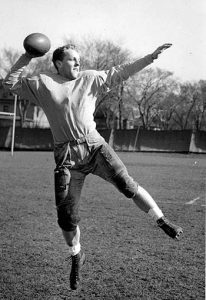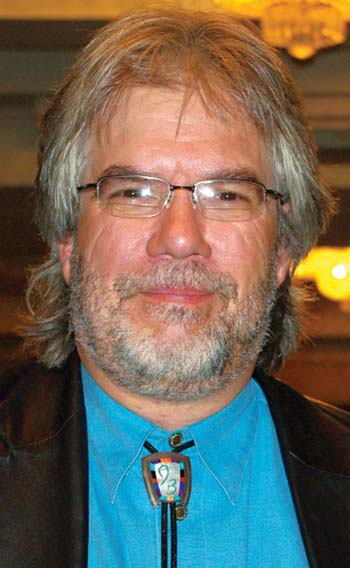 Let’s get this out of the way from the start. You can’t pay me enough to watch the 40 or more mostly mediocre (and often ludicrous) films about Jesse James and his outlaw gang that got their comeuppance on Division Street in Northfield on Sept. 7, 1876. Thankfully, Johnny D. Boggs has been paid to watch such movies and has authored a book, Jesse James and the Movies (McFarland & Co., 2011). Boggs gives a synopsis of plot, comments on the accuracy of the history (mostly inaccuracies), the players (including filming details) and provides his analysis (often amusing). So, relying on Boggs’ excellent book, the few movies I have seen and some research of my own, I present to you: Jesse James, Movie Star.
Let’s get this out of the way from the start. You can’t pay me enough to watch the 40 or more mostly mediocre (and often ludicrous) films about Jesse James and his outlaw gang that got their comeuppance on Division Street in Northfield on Sept. 7, 1876. Thankfully, Johnny D. Boggs has been paid to watch such movies and has authored a book, Jesse James and the Movies (McFarland & Co., 2011). Boggs gives a synopsis of plot, comments on the accuracy of the history (mostly inaccuracies), the players (including filming details) and provides his analysis (often amusing). So, relying on Boggs’ excellent book, the few movies I have seen and some research of my own, I present to you: Jesse James, Movie Star.
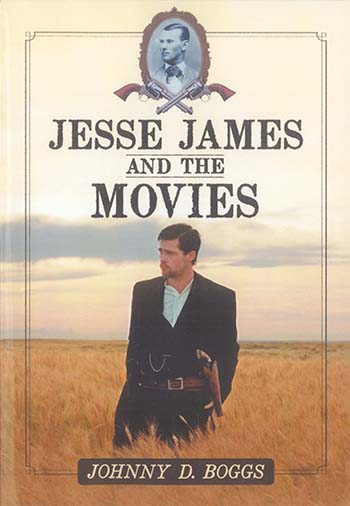 Only Billy the Kid outranks Jesse James in popularity in Hollywood Westerns. The first Jesse James movie Boggs remembers seeing in his native South Carolina was the 1972 film The Great Northfield Minnesota Raid as shown on network television. Boggs writes, “The elementary school playground the following week (or weeks) was full of young boys pretending to be Cole Younger, or at least actor Cliff Robertson’s version of Cole Younger…A lot of us thought that the James and Younger boys were merely carrying on the fight against Yankee tyranny and greedy railroaders.” (More on this movie later.)
Only Billy the Kid outranks Jesse James in popularity in Hollywood Westerns. The first Jesse James movie Boggs remembers seeing in his native South Carolina was the 1972 film The Great Northfield Minnesota Raid as shown on network television. Boggs writes, “The elementary school playground the following week (or weeks) was full of young boys pretending to be Cole Younger, or at least actor Cliff Robertson’s version of Cole Younger…A lot of us thought that the James and Younger boys were merely carrying on the fight against Yankee tyranny and greedy railroaders.” (More on this movie later.)
 Since many silent movies have been lost, Boggs says it is hard to get a count of how many early films were made about Jesse. The first movie appears to be The James Boys of Missouri in 1908. Two movies were released in March of 1921, Jesse James Under the Black Flag and Jesse James as Outlaw. Both were distinguished (or, rather, undistinguished) by the “horrible actor” Jesse Edward James (billed as Jesse James Jr.) who played his father in a romanticized, whitewashed version of the outlaw’s life. Boggs says that Jesse Jr. was “in his mid-40s, too old and overweight to be playing a teenage guerrilla pistol-fighter, but, then again, that has never stopped moviemakers.” The movie was “a commercial bomb.”
Since many silent movies have been lost, Boggs says it is hard to get a count of how many early films were made about Jesse. The first movie appears to be The James Boys of Missouri in 1908. Two movies were released in March of 1921, Jesse James Under the Black Flag and Jesse James as Outlaw. Both were distinguished (or, rather, undistinguished) by the “horrible actor” Jesse Edward James (billed as Jesse James Jr.) who played his father in a romanticized, whitewashed version of the outlaw’s life. Boggs says that Jesse Jr. was “in his mid-40s, too old and overweight to be playing a teenage guerrilla pistol-fighter, but, then again, that has never stopped moviemakers.” The movie was “a commercial bomb.”
Roy Rogers, “King of the Cowboys,” starred in two movies involving Jesse, as himself in Days of Jesse James (1939) and as Jesse in Jesse James at Bay (1941). Clayton Moore “played a heroic Jesse James, pitted against a bunch of masked raiders” in the 1947 serial Jesse James Rides Again and the 1948 serial Adventures of Frank and Jesse James. Moore went on to don a mask himself as the Lone Ranger, riding his trusty horse Silver to the strains of the William Tell Overture, starting in 1949. Boggs writes that movie serials died as they were quickly absorbed into television.
The first movie to cause a big stir in Northfield was the one Boggs says “defined Jesse James” when it came out in January of 1939. It was Jesse James, starring Tyrone Power as Jesse James and Henry Fonda as Frank James. Boggs reports that it was filmed at a budget of $1.6 million and made $3 million in earnings with only Gone With the Wind and Wizard of Oz beating it that year at the box office.
 I found a front-page Northfield News story from Jan. 19, 1939, with the headline “Northfield Outraged by Jesse James Film Story, Movie Implies Local Citizens were Tipped Off About Famous Raid.” The writer (probably editor Carl Weicht) wrote that while citizens might “smile indulgently” over “license with local history for dramatic effect,” they “object strenuously to the idea that, merely to save the reputation of Jesse James for his complete failure at Northfield, it was necessary to imply that the citizens of this little town were ready and waiting for him.” The facts are “that this efficient band of outlaws” met defeat at the hands of “quiet, ordinary citizens of a little college town, quite unprepared for their coming, except in courage and resourcefulness in defense of their rights and possessions…The producers of the movie may have a libel suit on their hands if indignation in Northfield continues to mount.” The Jan. 26 Northfield News headline was “Northfield Waiting to See How Bad ‘Jesse James’ Is” with a report that the town‘s “outraged feelings” had been sent out in an Associated Press dispatch which was picked up by papers throughout the U.S.
I found a front-page Northfield News story from Jan. 19, 1939, with the headline “Northfield Outraged by Jesse James Film Story, Movie Implies Local Citizens were Tipped Off About Famous Raid.” The writer (probably editor Carl Weicht) wrote that while citizens might “smile indulgently” over “license with local history for dramatic effect,” they “object strenuously to the idea that, merely to save the reputation of Jesse James for his complete failure at Northfield, it was necessary to imply that the citizens of this little town were ready and waiting for him.” The facts are “that this efficient band of outlaws” met defeat at the hands of “quiet, ordinary citizens of a little college town, quite unprepared for their coming, except in courage and resourcefulness in defense of their rights and possessions…The producers of the movie may have a libel suit on their hands if indignation in Northfield continues to mount.” The Jan. 26 Northfield News headline was “Northfield Waiting to See How Bad ‘Jesse James’ Is” with a report that the town‘s “outraged feelings” had been sent out in an Associated Press dispatch which was picked up by papers throughout the U.S.
 The movie had its Northwest premiere in St. Paul at the Paramount and in Northfield at the Grand Theatre on Jan. 27. In an “At the Theatre” column in the Jan. 26 Northfield Independent, theater manager Everett Dilley wrote: “In magnificent color, with sweeping drama and intense romance, fine American humor, ‘Jesse James,’ although slightly inaccurate historically, is a stirring film. Don’t miss it.” The Grand was packed for nine showings in four days.
The movie had its Northwest premiere in St. Paul at the Paramount and in Northfield at the Grand Theatre on Jan. 27. In an “At the Theatre” column in the Jan. 26 Northfield Independent, theater manager Everett Dilley wrote: “In magnificent color, with sweeping drama and intense romance, fine American humor, ‘Jesse James,’ although slightly inaccurate historically, is a stirring film. Don’t miss it.” The Grand was packed for nine showings in four days.
Also in the Jan. 26 Northfield News was a letter to the editor signed “Mrs. Tree” in which she complained, “Must we always be made famous by news that’s sixty years old?…I’ll bet you couldn’t get The News for a single year without mentioning the Younger brothers or the bank robbery. You can’t even print obituaries without mentioning that old raid. ‘Mrs. So-and-so will be remembered as the granddaughter of Mrs. Whoosit, who was an eye-witness to the bank raid in the back yard dumping the ash pan when she heard the hoof beats of the robbers’ horses as they fled from town.’”
On Feb. 2, Northfield News editor Carl Weicht wrote that the bank raid episode in the movie was correct only in the name of the bank and a few sentences read from a newspaper account. “Darryl Zanuck and his Hollywood gang have taken away from Northfield by alleging that the pioneer heroes had advance knowledge of the impending raid, and prepared for it, more than Jesse James ever stole from this town.” (In the movie, gang member Bob Ford–who in reality did not team up with Jesse until about 1880 and assassinated him in 1882–clues a detective in on the Northfield raid in a bid for amnesty, leading to an ambush of the gang at First National Bank).
Boggs notes in his book that “Nunnally Johnson’s screenplay helped propagate the myth that Jesse James was fighting evil railroads…The movie proved incredibly popular, but its facts were basically nonexistent.” Boggs quotes Jesse’s granddaughter Jo Frances James as saying, “About the only connection it had with fact was that there once was a man named James and he did ride a horse.” (And Jesse and Frank did not ride their horses through plate-glass windows and through a store on Division Street and then leap their horses off a 60-foot-cliff into a lake during their escape, as depicted in this movie.)
Boggs takes note of the proliferation of Jesse James movies from 1950 to 1960. In The Great Missouri Raid (1951), the Northfield bank robbery is surprisingly turned into a robbery of a Missouri Central railroad instead. In Jesse James’ Women (1954), Boggs writes, “The exploitation of Jesse James’ name in the 1950s hits an all-time low as Jesse is turned into a Casanova.” Two women fight over Jesse in a saloon, a fight which only ends when Jesse pours a bucket of beer on their heads.

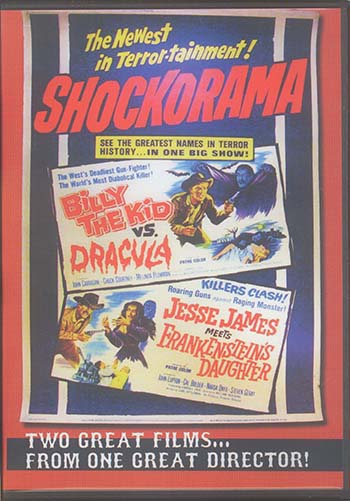 I was loaned a DVD of The True Story of Jesse James from 1957, starring Robert Wagner as Jesse, Jeffrey Hunter as Frank James, Hope Lange as Jesse’s wife Zee, Agnes Moorehead as Zerelda, the mother of the James boys. As you might suspect by now, the “True Story” was anything but. The movie starts with the Northfield raid, including the bogus window-shattering escape of the James boys and their leap with horses off a cliff lifted from the 1939 movie (both were 20th Century-Fox productions). The back cover of the DVD says, “As he attempts to evade the law, those who know him best ponder the question, ‘What turned this simple farm boy to a life of lawlessness?’”
I was loaned a DVD of The True Story of Jesse James from 1957, starring Robert Wagner as Jesse, Jeffrey Hunter as Frank James, Hope Lange as Jesse’s wife Zee, Agnes Moorehead as Zerelda, the mother of the James boys. As you might suspect by now, the “True Story” was anything but. The movie starts with the Northfield raid, including the bogus window-shattering escape of the James boys and their leap with horses off a cliff lifted from the 1939 movie (both were 20th Century-Fox productions). The back cover of the DVD says, “As he attempts to evade the law, those who know him best ponder the question, ‘What turned this simple farm boy to a life of lawlessness?’”
The answer? Boggs writes that in the 1950s the theme was “juvenile rebelliousness,” while “previous movie versions pictured Jesse as a good-man-turned bad while fighting the system.” Nicholas Ray, the director of this movie, had directed James Dean in what Boggs calls the “standard of teen angst and rebellion, Rebel Without a Cause (1955), earning an Academy Award nomination for his screenplay.” Dean might have been Ray’s choice to play Jesse but died in a car crash in 1955 at the age of 24. The second choice was said to be Elvis Presley, but Robert Wagner was cast as Jesse.
Jesse certainly is a vainglorious young man. Frank says to his brother, “Northfield was the end of the line for all of us. Everything went wrong. In the beginning we had a reason. It was for Zee and Ma and protecting the farm.” Then the gang ended up 400 miles from home. “Who are we fighting for?” Frank cries. “Ma? Zee? FOR YOU!”
Jesse sneers, “Me? I’ve carried you, Cole and the rest on my back for years! If it weren’t for me, you’d all be sharecroppers on a farm.”
Boggs notes that this movie might be the first to “depict the legendary myth of Jesse saving the widow from the banker.” A poor widow feeds the gang at her farmhouse and tells them of a pending foreclosure. Jesse gives her the $600 she needs (“Compliments of Jesse James!”) and tells her to be sure to get a receipt. (“What a noble man!” she says.) After the gang leaves, the banker rides up, gives her a receipt, then leaves. Of course, Jesse then robs the banker. Boggs says, “Most historians dismiss that story as hogwash.”
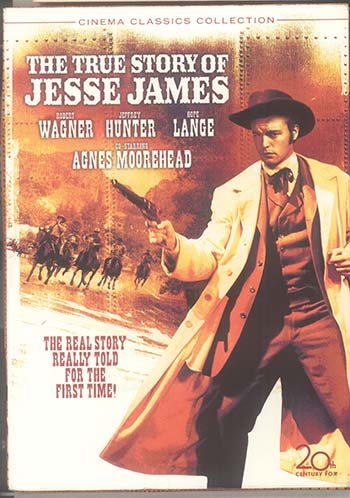 I found it amusing when Cole picks up one of the dime novels that glorifies the gang and says he is reading about Jesse being misunderstood. “He gives it all to the poor. It’s all I can do to hold the tears back.” Also amusing is Jesse’s assessment of Northfield:
I found it amusing when Cole picks up one of the dime novels that glorifies the gang and says he is reading about Jesse being misunderstood. “He gives it all to the poor. It’s all I can do to hold the tears back.” Also amusing is Jesse’s assessment of Northfield:
“It’s a dinky little town but they’ve got a bank up there that’s never been touched.” Cole’s response: “People will really talk about this one, won’t they, Jesse?”
In the 1959 movie Alias Jesse James Bob Hope stars as an inept insurance salesman who unwittingly sells a policy to Jesse James (Wendell Corey) and needs to buy it back. Rhonda Fleming plays Jesse’s girlfriend. Nothing fact-based here. And I am pretty sure Jesse never met the Three Stooges as shown in the 1965 movie “The Outlaws IS Coming!”
Boggs writes that Jesse has the “non-distinction” of being in one of the worst horror films ever made, Jesse James Meets Frankenstein’s Daughter from 1966. This movie is paired with Billy the Kid vs. Dracula under the title “Shockorama.” Boggs says this has “enjoyed some success as a cult film” since “some movies are so terribly acted, so ridiculous, so cheaply produced, they become unintentionally hilarious.” I agree. You can find it on Youtube and at the Northfield Historical Society museum store. Boggs suggests having a couple beers before you see it.
Having Northfield in the title is about the only thing to recommend in the 1972 movie The Great Northfield Minnesota Raid, directed and written by Philip Kaufman, despite noted actors Cliff Robertson as Cole Younger and Robert Duvall as Jesse James. Jesse has an evangelistic “vision” about robbing the supposed “largest bank West of the Mississippi.” Cole arrives first and, posing as a visiting cattleman, attends a local baseball game between Northfield and St. Paul, with a majestic mountain range in the background (the movie was filmed in Jacksonville, Oregon). When told “Baseball is our national sport,” Cole replies, “Our national sport is shooting and it always will be” and he proceeds to shoot the ball out of the sky with his rifle to end the game. Cole finds out the bank failures of 1873 have kept Northfielders from depositing money, so he schemes with the bank president to con them into doing so, a plot device deemed “juvenile and idiotic” by Boggs (as, of course, it is).
When the gang comes together, they find time to visit a bathhouse and the “House of Light Love.” Thus refreshed, the gang rides into Northfield past a church (with the strains of the St. Olaf Choir on the soundtrack) to rob the now gold-laden bank. During the robbery, an insane old man named Gustavson is shot by Bob Younger and falls onto a calliope with the resulting sound announcing the robbery to the citizens. Cole had fixed the malfunctioning calliope earlier and is also to blame for having taught a bespectacled young Henry Wheeler how to shoot a rifle—a bad idea since Wheeler is a marksman in the shootout with the outlaws. What irony!
Bob Warn reviewed the movie in the Northfield News of May 25, 1972. Jesse is portrayed as “nasty, superstitious, fanatic, bent on blind vengeance to all Northerners,” while Cole is “an earthy, vulnerable man with generous and idealistic impulses.” Northfield is shown at the end “happily cheering the badly wounded, leather (knights armour?) vested, bleeding Cole Younger as he struggles to his feet in his jail cart, while an awed voice intones: ‘The cheering crowd then followed Cole Younger all the way to the jail in Stillwater.’” Warn’s comment: “Balderdash!”
Boggs writes that many consider the 1980 film The Long Riders to be “the best Jesse James movie.” Director Walter Hill “fashions a series of vignettes to illustrate the outlaw’s post-Civil War career, focusing more on the relationships between the outlaws than on their crimes.” Brothers play brothers in this movie: David Carradine as Cole Younger, Keith Carradine as Jim Younger, Robert Carradine as Bob Younger, James Keach as Jesse James, Stacy Keach as Frank James, Dennis Quaid as Ed Miller, Randy Quaid as Clell Miller, Christopher Guest as Charlie Ford and Nicholas Guest as Bob Ford.
Among the caveats of the robbery scene in Northfield: “The Pinkertons [detectives] told us you might be coming,” says Joseph Lee Heywood before he is one of two bankers shot to death inside the bank. And again the outlaws ride horses through plate glass windows during the escape.
Boggs praises the period music by Ry Cooder in the film and the “wonderful feel and look to it.” But he feels it was “more of a gimmick film” and “just didn’t quite pull things off.”
The Assassination of Jesse James by the Coward Robert Ford (2007) was one of the last movies at Southgate Theater in Northfield. It was directed by Andrew Dominik, who based his screenplay on Ron Hansen’s 1983 literary novel by the same name. Brad Pitt starred as Jesse James and Casey Affleck as Robert Ford, with Sam Shepard as Frank James and Mary-Louise Parker as Zee James. Boggs reports that reviews were mixed, although Casey Affleck earned an Academy Award nomination as Best Supporting Actor. “Without much of a push from Warner Brothers, it performed poorly at the box office,” writes Boggs. Boggs considers it the “best movie about Jesse James in both historical accuracy and entertainment terms” but calls it “more art film than Western, so it certainly won’t appeal to all tastes. It’s just too bad more people didn’t see it.”
Boggs e-mailed me that the “cinematography sweeps me away” and “you can’t underestimate Casey Affleck’s performance as Bob Ford.” But “the movie that sticks with me most is Sam Fuller’s I Shot Jesse James from 1949 which “mesmerizes me,” though it is a B production with “scripting problems and flawed history.”
Hayes Scriven, executive director of the Northfield Historical Society, says that he likes both The Long Riders and The Assassination of Jesse James by the Coward Robert Ford. Scriven says Long Riders is more entertaining, but The Assassination is a “very close second,” because he has read Hansen’s book.
Chip DeMann, leader of the current James-Younger Gang, portrayed Jesse on television in 1981 (see box). He also praises the Hansen novel and says The Assassination will “probably go down as the best James-Younger film for years to come. For overall perfection, I have to go with Brad Pitt on this one.”
Judge James R. Ross told the Los Angeles Times in 2001: “I’ve spent 50 years opposing the most popular myths associated with my great-grandfather and I challenge anyone to point out any movie that is more exciting than the real story.”
I encourage you to visit the historic First National Bank in the Northfield Historical Society Museum at 408 Division Street S. to get the “truth is stranger (and more exciting) than fiction” story. By the way, in September of 2005, Judge Ross (who was judge of the Orange County Superior Court in California from 1983-1995 and died in 2007) rode in the Defeat of Jesse James Days parade with the present-day James-Younger Gang. He admitted to being a “cowboy wannabe.” He also sang karaoke for the first time with me one evening at Froggy Bottoms. I couldn’t help wondering if his great-grandfather might be spinning in his grave in Missouri.
In Search of Jesse James in Northfield
A nationally syndicated television program “In Search of…..” filmed part of an episode in Northfield during the first weekend of May in 1981. What were they in search of? Jesse James, of course. The premise of this show, narrated after completion by Leonard Nimoy (Spock of “Star Trek”), was that perhaps Jesse was not killed by Robert Ford in St. Joseph, Missouri, in 1882, but somehow lived on.
Chip DeMann of Dundas, leader of the James-Younger Gang re-creators, was chosen to play Jesse James. Ted Scott, Scott Richardson and David Hvistendahl were cast as bankers, with other townspeople also taking on roles.
Scott Richardson wrote in the Northfield News of May 7, 1981: “Five Northfield area Jaycees hauled in three yards of dirt to provide some 1876 flavor to the street in front of the bank. They picked it back up again four hours later with the help of the Northfield Fire Department and its hoses…Chuck, Chip, Jerry and Doug DeMann, Wayne Eddy, Herman Transburg, Wayne Laabs and Jane Moline played the James-Younger gang. Between 150 and 200 onlookers watched.”
Outlaw Jane Moline? Yes, Chip told me his wife was recruited when one of his relatives (who shall remain nameless here) didn’t show up after having been to his Prom the night before.
Besides filming the bank robbery at the Scriver Building, the Los Angeles film crew also shot a campfire scene at the DeMann farm and also filmed at the Waterford Bridge. A financial contribution was made to the Northfield Historical Society and local expenses covered.
Chip DeMann also portrayed Jesse throughout the filming in Missouri for yet another bank robbery scene in Liberty and the assassination scene in St. Joseph. Chip told me the crew filmed a burial scene in a freshly dug grave on the James Family farm near Kearney. Chip (as Jesse) is shown in the ground in the casket. Jesse’s weeping widow Zee throws a bouquet of roses into the casket on top of him as the casket closes.
“There was a wasp among the roses. I kept quiet and waited until I thought they had filmed enough,” said Chip. Then he yelled, “CUT! Get me out of here!”
The “In Search of Jesse James” episode can be found on Youtube.


